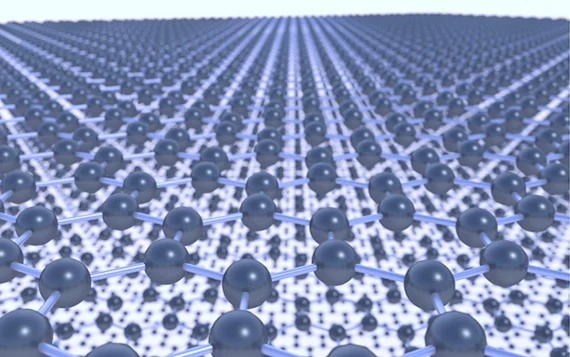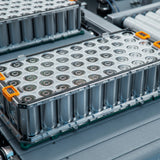Graphene Properties and Applications

Graphene materials have ultrahigh surface area, high strength, and exceptional conductivity making them highly valuable for various applications. Its large surface area enhances energy storage, sensor sensitivity, and water purification efficiency. Graphene's incredible strength and lightweight nature are ideal for flexible electronics and mechanical reinforcement. Additionally, its excellent electrical and thermal conductivity support advanced electronic devices, energy storage systems, and efficient heat management.
| Properties | Graphene |
|---|---|
| Dimensionality | 2D |
| Thickness |
~ 1 nm, one atom thick |
| Surface Area |
Extremely high specific surface area - ~2600 m2/g |
| Appearance | Transparent and colorless |
| Strength |
Strongest material known to exist: Tensile strength = 130 GPa Elastic Modulus = 1.1 TPa |
| Bonding |
Each carbon participates in three σ bonds (C-C) and a π bond (hybridized sp2 bonding) Bond lengths = 0.142 nm |
| Conductivity |
Exceptionally electrically and thermally conductive: Thermal Conductivity = 5 x 103 W/mK Electron Conductivity = 106 S/m Resistance = 31 Ω/sq Electron mobility = (2 x 105 cm2/V.s) Zero-gap semiconductor/semimetal |
| Stability |
Chemically reactive edges and surface which can be functionalised with other elements |
Ultra-high Surface Area
The ultrahigh specific surface area (~2600 m2/g ) of graphene is a result of it being 2D and therefore majority exposed surface. This property is crucial for surface active applications such as:

Energy Storage
Graphene has a greater charge accumulation in supercapacitors resulting in high energy and power densities. This is as a result of its high surface area which leads to more efficient ion transport in lithium ion batteries.
Sensors
The surface of graphene is highly sensitive to changes in environment producing a measurable response to gases, biomolecules and chemicals. Graphene can be modified with receptors to enable selectivity.
Water Purification
Graphene effectively removes contaminants and pathogens at a molecular level.
Composite Materials
The high surface area ensures better interaction with the matrix material, enhancing the mechanical, thermal, and electrical properties of the composite.
Solar Cells
Graphene improves the efficiency of charge collection and transport, leading to more efficient photovoltaic devices.
Conductive Inks and Coatings
Graphene enhances the conductivity of inks and pastes used in printed electronics, flexible circuits, and transparent conductive films.
High Strength
Graphene is the strongest material known to exist. It is predicted to withstand 130 GPa of stress before breaking. This is referred to as its tensile strength value. 130 GPa is approximately 1.2 million times greater than atmospheric pressure. For comparison, diamond has a tensile strength of 2.8 GPa which can be as high as 80-90 GPa on the microscale.
Graphene’s elastic modulus (1.1 TPa) describes the ratio of applied stress to change in shape. This huge value means that graphene holds strong under immense stress. Being both incredibly strong and stiff as well as lightweight makes graphene suitable for a wide range of applications.

Flexible Electronics
Graphene is seen as a strong alternative for current electrodes substrates such as ITO which is brittle and chemically unstable. Graphene has been used in light-emitting diodes, solar cells and field-effect transistors. Graphene is also being used within wearable electronics such as sensors which can monitor human health.
Mechanical Reinforcement
Even very low loadings of graphene within a composite material such as polymers or concrete can provide significant reinforcement. Less than 1% (by weight) graphene additives sees significant improvements. This makes graphene composites attractive for replacing metals in applications such as construction, automotive and aerospace. Graphene-reinforced materials are being used to manufacture high-performance sports equipment, such as tennis rackets, bicycle frames, and helmets, offering improved strength and reduced weight. This includes grip on trainers which are 50% more hard wearing and last more than 1,000 miles.
Biomedicine
Graphene based nanocomposites have been used for tissue engineering and regenerative medicine. Graphene imparts high strength to the engineering of bone, nerve, heart and muscle. It can promote stem cells to grow and develop into specific types of cells.
Conductivity
Graphene is exceptionally electrically and thermally conductive. Graphene has an electron conductivity of 106 S/m and thermal conductivity of 5 x 103 W/mK . Electrons can flow very easily (electron mobility is 2 x 105 cm2/V.s ) with very little resistance (31 Ω/sq ). This makes graphene suitable for a range of electronic and thermal applications, including:
Electronics
The use of graphene materials in flexible electronics has already been mentioned. The combination of transparency, strength, flexibility, and high electrical conductivity makes it attractive to researchers across various fields. This includes a range of electronic applications, such as:

Field Effect Transistors
Graphene transistors can operate at higher speeds than traditional silicon transistors (electron mobility of ≤1400 cm2/V.s – 140 times slower than graphene). Graphene excellent stability, low-power operation and low-cost fabrication. This means graphene is suitable for future high-speed electronics.
Semiconductors
Graphene has been used as a semiconductor through recent developments in processing so that it has a band gap. This means electrons can hop from lower energy to higher energy states, allowing for a switching from “on” and “off”. It can either being conducting or not conducting which creates the binary (ones and zeros) system needed for computors.
Energy Storage
Systems where both the anode and cathode are made with graphene materials are promising alternative energy-storage devices. Reactions happen quickly at both graphene electrodes. This is because graphene is a porous (honeycomb-like) material with high electrical conductivity. This means graphene batteries have high power and energy density. Graphene batteries are comparable to conventional lithium ion batteries and are seen as a promising alternative due to their higher power density.
The advancement of electronic devices has brought with it the need for improving thermal management. Effective heat dissipation management in electronic devices is crucial for ongoing advancements.
Thermal Applications
Graphene can be incorporated into thermal interface materials (TIMs) to enhance heat transfer between components, leading to more efficient cooling in electronics. ). Graphene has been used in the cooling of photovoltaic solar panels in order to reduce deterioration caused by high temperatures.
The high thermal conductivity and compatibility with different materials means graphene can be applied to reduce the build-up of heat. This is particularly useful for high-power-batteries where temperature rises can negatively impact performance or lead to cell rupture and in the worst cases explosions. Graphene can be used to improve thermal conductivity within a battery without degrading heat storage ability.
Graphene Materials

Learn More
 Graphene vs Graphite
Graphene vs Graphite
Graphene is a single layer of carbon atoms arranged in a hexagonal pattern, like a sheet of paper. Graphite, on the other hand, is made up of many layers of graphene stacked on top of each other, like a stack of paper.
Read more... Graphene Batteries
Graphene Batteries
Graphene batteries are advanced energy storage devices. Graphene materials are two-dimensional and are typically made solely of carbon.
Read more...References
- Graphene, related two-dimensional crystals, and hybrid systems for..., Bonaccorso, F. et al., Science (2015)
- Measurement of the Elastic Properties and Intrinsic Strength..., Lee, C. et al., Science (2008)
- Graphene synthesis, characterization and its applications: A review., Mbayachi, V. B. et al., Results Chem. (2021)
- Graphene Electronics: Materials, Devices, and Circuits., Wu, Y. et al., Proceedings of the IEEE. (2013)
- The role of graphene in rechargeable lithium batteries:..., Ali, A. et al., Nano Materials Science (2022)